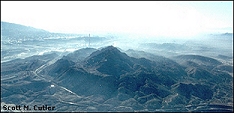

Most days we see blue skies in our Chihuahuan Desert, but on our moon, which has no atmosphere, the sky is black. Outside the earth's atmosphere, the darkness of space is only interrupted by pinpoints of distant stars and the disk of the sun. The white light from our sun is actually composed of all colors of the rainbow, with different colors having different wavelengths.
On earth we see our sky as blue because the average molecule in our
atmosphere is just the right size to scatter blue light in our direction. When
pollution consists of lots of particles of dust and debris, all wavelengths of the
sunlight are scattered toward us, making the sky more gray or white. These particles
may come from automobile exhaust, factories, fires, or perhaps windstorms. If you want
to measure pollution from these particles for yourself, take a look at the sky. Is it a
bright pristine blue or a subtle gray?

Listen to the Audio (mp3 format) as recorded by KTEP, Public Radio for the Southwest.
Contributor: Florence E. Schwein, Centennial Museum, University of Texas at El Paso.
Desert Diary is a joint production of the Centennial Museum and KTEP National Public Radio at the University of Texas at El Paso.


Left: The Chihuahuan Desert blue sky over the Franklin Mountains of Trans-Pecos Texas (photograph by Arthur H. Harris). Right: Pollution trapped by a temperature inversion, El Paso, Texas. Cerro Cristo Rey in foreground (photograph by Scott M. Cutler).